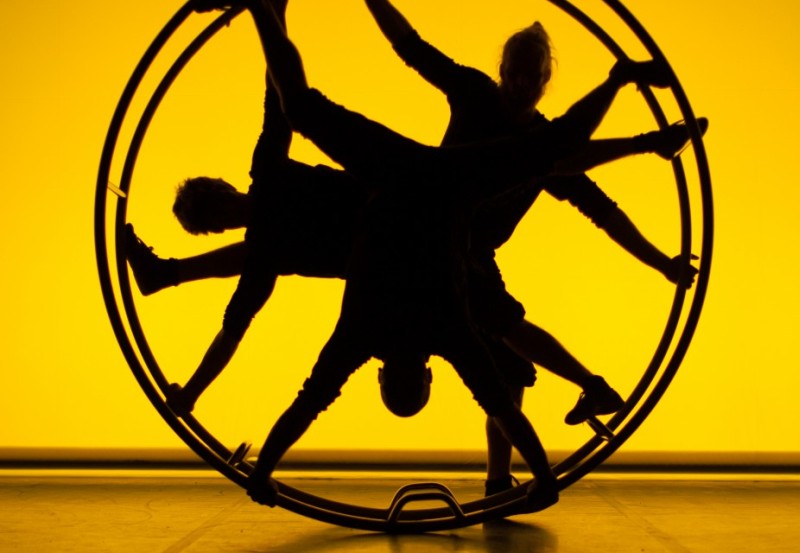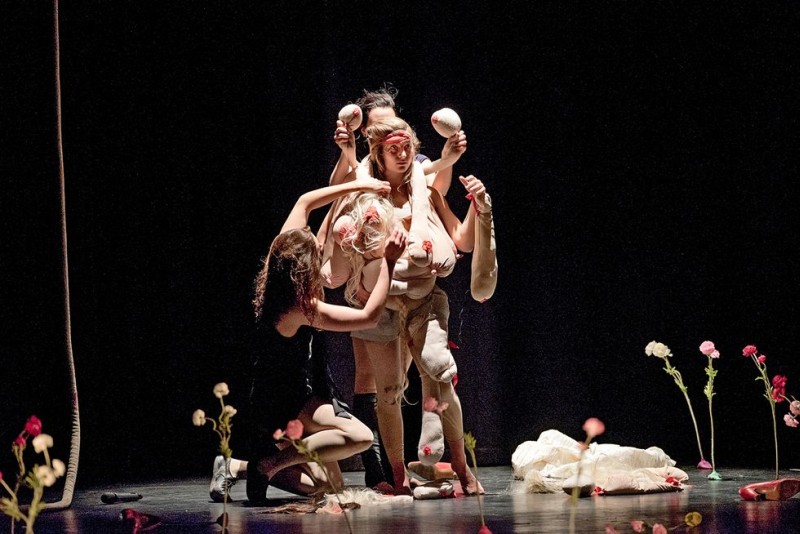 Two Scandinavian companies brought their explorations of circus and gender to this year’s Circus City, Bristol’s biennial circus festival.
Two Scandinavian companies brought their explorations of circus and gender to this year’s Circus City, Bristol’s biennial circus festival.
The most powerful image that stays with me from all-male Swedish company Sisters’ exploration of precision physical interaction – Clockwork – is of men flying through the air, pole to pole, like silent gibbons. Not a mechanical image, as suggested by the title of the piece, but a primate one. When I watched these movements I could feel air rushing past my ears, my arm getting ready to receive weight and pass it over quickly. These things are something my body knows about although I have never, could never, replicate them. That’s a good reason to go to the circus – to get vicarious satisfactions. The second most striking image I retain is of a naked man, tied up, hanging by his hair, and the audience laughing, me included.
The company describe the show as aiming to create ‘a universe where the human body can be lots of other things… the metamorphosis of coming from three individuals to one being.’
This appearance of metamorphosis was certainly achieved at times to great effect. Not only did they frequently interact as one, they created diverse images and the attempts to achieve these ‘like clockwork’ foregrounded the risks of their acts. As spectators, our human consciousness keeps us focused on this duality of being: we wish to fly but are afraid of falling, only our primate cousins enjoy aerial ease. The physical demands of pushing human limitation, this ‘oneness’, including vibrant, precise work with the German Wheel and the Chinese Poles, is only possible to sustain for short periods. Between acts, Sisters use playful and competitive interactive clowning and tricks such as putting limbs in boxes and creating the illusion that they are turned the wrong way. Body parts are crunched, heads and shoulders displaced. The body becomes the site of both cruelty and humour, as an individual entity and a communal one. Clockwork is a story of denial; it displays and disputes notions of the fallible and limited human body.
In contrast, the inaugural show, Vixen, by new all-female Danish ensemble Tanter worked in a different way to connect to my ‘inner animal’ and understandably so because, as the show’s ambivalent animalistic title suggests, the piece explores negative stereotyping of women. Feminist critiques of the images of the Madonna, whores, and mad women are well-trodden ground. But, as an audience member, the interest comes from seeing their treatment, and that such images are still compelling and relevant to performers and audiences. Three women appear from behind the back curtain, their fox fur hats fall over their faces so they can’t see, they wear red high heels and carry full wine glasses. They totter, struggle, try to dance, fall over, they echo the debasement of ladette excesses that supposedly demonstrate a good night out. One gets up (Karoline Aamås), loosens her fantastic flowing long hair, freaks out and attempts ‘escape’ by climbing a rope while the remaining two do sort of mock-porn ‘girl on girl’ things on the other side of the stage. The rope escape is presented as treacherous, hair all over the place (convincingly seeming to threaten the performer’s grip I thought), and she eventually falls from some height (on to a mattress) – that is, she fails.
Within the piece, circus skills present composite images of both dilemma and achievement marked by intersecting improvised and choreographed sequences. The slack rope walking depicts both the actual skill of the performer (Moa Asklöf) and the psychological position of feeling unsafe, trapped, and confined by fear of failure. Conversely, towards the end of the piece, when nearly all the scenes have hitherto been presented humorously, the high trapeze act (Elise Bjerkelund Reine) is framed as an epiphany, suggested by the sudden opening of the back curtain, revealing the altar and stained glass windows at the back of the church that houses Circomedia. As Elise descends she makes the traditional gesture that invites applause – broad smile, the opening of the arms with flat, upturned hands, and we, the audience, responded accordingly. It was wonderful work but strangely out of character with the rest of the piece. Vixen is essentially a story of harm and nowhere is this more poignant than when Karoline, at the front of the stage, cuts an onion and puts the two halves against her eyes giving her the appearance of a monstrous insect. The audience winces and laughs at this real, if minor, act of self-harm.
Both shows raise interesting questions about how traditional circus acrobatics can be incorporated into contemporary narratives. There are implicit paradoxes in their themes – the body as machine; woman as an idea rubbing up against physical, emotional reality – and these tensions are formally exploited as the companies play with exploring a position by presenting its opposite or skilfully presenting the physical joke of the ‘incompetent performer’. Whilst very different both effectively use circus’s formal qualities – to present skills and highlight their subversion; to emphasise physical realities and limitations and to create powerful and striking imagery – in order to explore their themes with sophistication and style.

